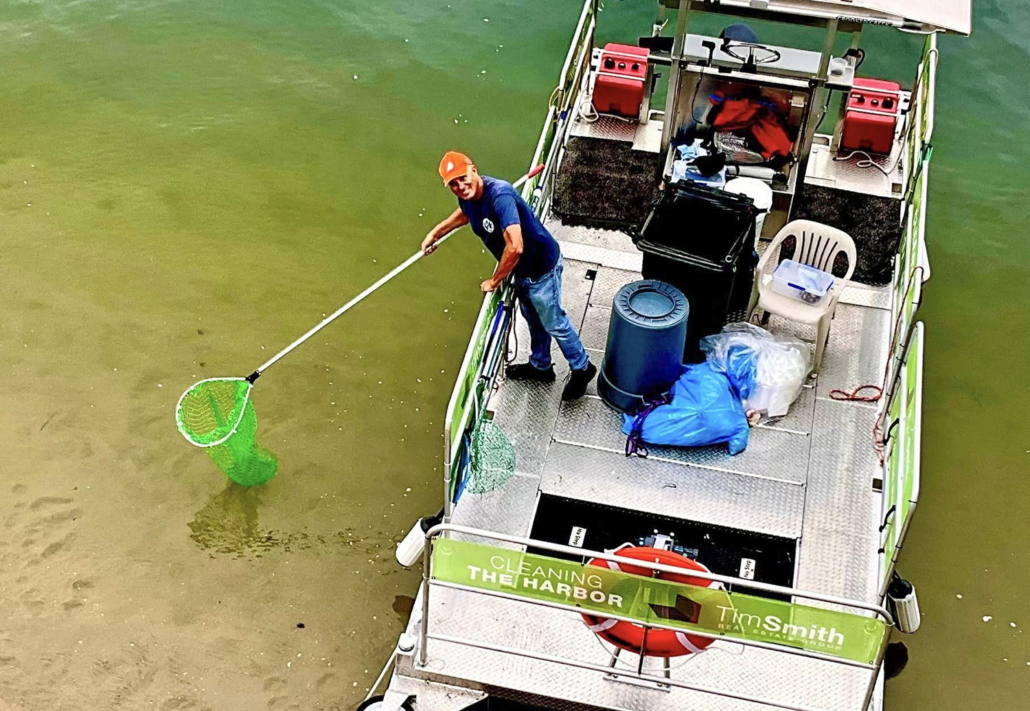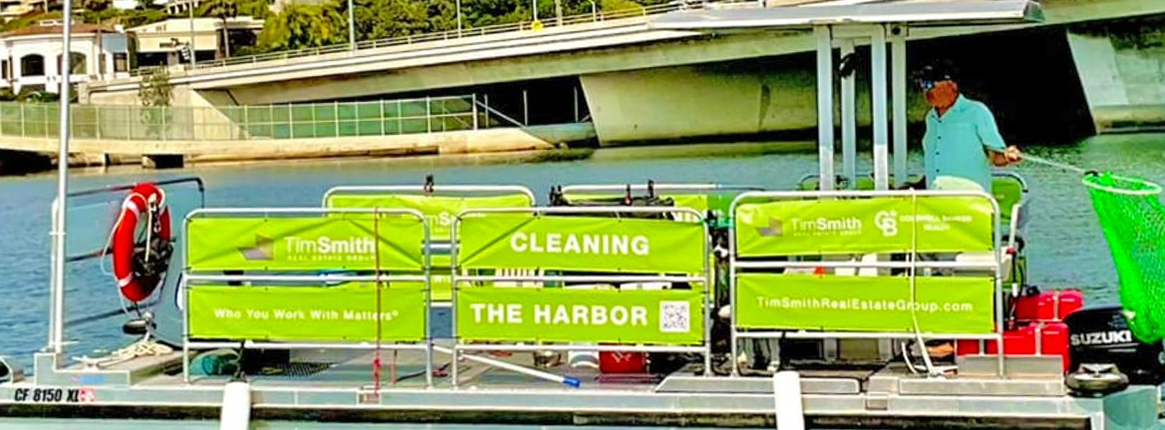Good ‘Seamaritan’ Sets a Course to a Trash-Free Harbor
Source: Newport Beach Independent Good Seamaritan sets a Course to a Trash Free Harbor
Having sold four of the five highest-priced Newport Harbor waterfront homes during his 24-year sales career, Coldwell-Banker realtor Tim Smith has been “cleaning up,” but not in the way you might think.
An avid fisherman (he owns a Boston Whaler Realm 38’) and Dover Shores resident who “loves this harbor,” Smith has been focused on how he can help make the bay as clean as possible.
The answer came from his firm’s marketing partner, Greg Blake, who asked, “What if we had a boat and a crew to clean the bay?”
It was textbook service marketing, where company efforts both promote good for the community as a whole, while hopefully generating the attention of potential clients.
To that end, Smith ordered a “skimmer,” an all-aluminum, flat-decked, outboard- powered catamaran workboat designed by Elastec Boats of Carmi, IL to suck up floating trash. Fitted out, the vessel cost $120,000 and took a year to build. The Smith Team christened her “The Good Seamaritan.”
She has now been in service for just over three months under the command of local Capt. Robert Sloan. Although he currently works but three days a week, Sloan and the “Good Seamaritan” have collected and ferried thousands of pounds of trash to an offload zone at Marina Park.

Unless one gets down and dirty, it’s hard to realize just what floats above and just under the surface of bay water.
“The most common things I pull out are plastic water bottles, cups and lids, tennis shoes, large wood logs, plus other wooden objects and polypropylene line,” shared the skipper.
On one outing, Sloan snagged a 25-foot waterlogged log, which he had to tow to Marina Park. On his most prolific day to date, the skipper offloaded 550 pounds of trash. He uses boat hooks and a variety of nets that he has purchased to capture the flotsam and has become “good at driving and collecting” without having to stop. Except for that log.
“The more extreme the tides, the more extreme the trash,” Sloan observes. Depending on those tides, the trash seems to collect in certain areas — which he knows well from having skippered a variety of boats for several companies in the harbor since 1985. In terms of collecting, Sloan generally patrols between the Newport Aquatic Center and the harbor jetties.
Although most often crewing and collecting by himself, he is never alone, for his long time partner, Xena, always joins him. Xena is a giant mutt that fits that salty description, “old sea dog.” Sloan, however, is looking for human volunteers to help spot and haul in the trash.
Skipper Sloan doesn’t always concentrate on flotsam; he’ll often stop at various beaches, docks and residences along the route to sweep or rake up the jetsam. Although he now gets paid for his efforts, Sloan has made it a practice for a couple of decades to scoop up anything that pollutes the waters. He is well known along the waterfront for his work.
In the long haul, “Good Seamaritan” may become one of the more famous boats afloat in Newport, even though it will have a trashy reputation—but in this case, that’s a good thing.
Source: Newport Beach Independent Good Seamaritan sets a Course to a Trash Free Harbor
Share this entry
Chairman Murray and Members of the Santa Ana Regional Water Quality Control Board:
My name is Dennis Durgan and I serve as Chairman of the Newport Harbor Foundation. The Foundation was founded in 2019 for the purpose of preserving, protecting and enhancing Newport Harbor for the benefit of the City of Newport Beach, the homeowners on or near the bay, the commercial operators in the bay, and the recreational users of the bay. The Foundation’s founders, contributors, and members are made up of individuals and business who have a long history of using and enjoying the harbor and a vested interest in its enhancement and preservation for use by current and future generations. On behalf the Foundation and its Board of Directors, I am reaching out to you to express our support for the currently pending project for dredging of Newport Harbor and construction of the confined aquatic disposal (CAD) site.
Hello friends of the Newport Harbor Foundation,
There is an urgent issue we need a little help with… something that impacts one of our favorite local playgrounds – the Newport Harbor.
After years of lobbying the federal government for help, the City of Newport Beach has obtained grants of almost $16 million to pay for dredging of the harbor which will significantly enhance the quality of water and create safer boat passage in the harbor. Along with the dredging process, there is a process called CAD (contained aquatic disposal) which places unsuitable material now existing in the harbor into a safe and secure location deep below the harbor bed. This process is totally safe and has been used for many years all over the country, including harbors in California.
By Phillip Palmer
ABC Eyewitness News, Los Angeles
NEWPORT BEACH, Calif. (KABC) — Keeping garbage out of the ocean isn’t easy. So enter Mr. Trash Wheel, the 70-square-foot barge gobbling up garbage by the ton to keep the beach and ocean pristine.
Trash in the streets ends up in the river and then from the river, the ocean.
Hoping to reduce the amount of trash making it to the ocean, Newport Beach is set to become the first west coast city to use a water wheel system to scoop up trash headed toward Upper Newport Bay.
“We really need to knock that trash load down. This is not going to be a silver bullet, it’s not going to get everything, but it’s going to get a big slug of stuff,” said John Kappeler, a senior engineer for the city of Newport Beach.



RIGHT ON ROBERT!
The Sloan’s and Giddings’ have been friends for close to seven decades, and sailed the area for many years before that. Our parents even built a boat together in the 50’s, and our mothers were classmates at NHHS.
As a kid, I was lucky enough to have met him in my Lahaina, when he and his dad were doing a gear delivery for Trans-pac. Coincidentally, we had no idea about the family connection, but became fast friends and have remained so ever since.
They just don’t make ’em better than Rob. He’s true blue, a great sailor, and a super guy, I’m proud to call (as we say in Hawai’i), one bruddah from one noddah moddah.
Aloha Nui